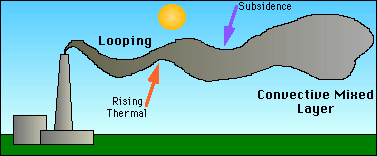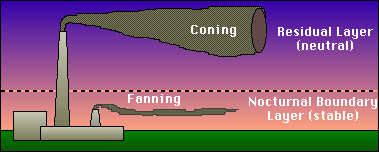|
|
Mixing HeightBecause turbulent fluxes vary based on surface heating and other factors, the height of the PBL also varies. At night, the height of the PBL decreases dramatically as the stable layer forms. The height of the PBL is called the mixing height, because it is the height up to which the air is well-mixed. The mixing height is very important to air quality experts when determining air pollution dispersion. Meanwhile, we'll look at some of the factors which influence the PBL. Because the PBL is the layer in which we live, and also the layer which we pollute, air quality issues and studies quite often deal with processes and motion in the PBL. Let's look at some examples.We discussed in a previous reading the structure of the PBL, including the mixed, stable, and residual layers. Let's say a factory is releasing chemical pollutants from a tall stack. During the day, the pollution is released into the mixed layer. The convection within the mixed layer quickly disperses the pollutants downwind. We also notice the typical looping of the plume. This is caused by rising thermals in some areas and subsidence in others. Subsidence is higher pressure air which sinks. On a day with lots of puffy cumulus clouds, the clouds are areas of upward motion and the clear sky around the clouds indicates areas of subsidence. The combination of rising and sinking air quickly mixes the pollutants from the stack and leads to the looping plume. The rapid mixing of particles in the mixed layer is beneficial in that it prevents the build-up of pollution into dangerous concentrations in any one area.
 If a similar factory were to release pollution during the night from a tall stack, the plume would spread out evenly, a process called coning. This is due to the neutrally stable profile of the residual layer. If a plume were released from a short stack within the stable layer, the plume would not disperse very quickly and behave in the process called fanning (if you were looking down on the factory, it would look like a fan of smoke). Coning disperses particles more effectively than fanning. Fanning disperses pollution in the horizontal, but not very effectively in the vertical.
 Pollution also influences rain and fog in the PBL. It is the pollutants that are trapped in the PBL that collect in clouds and then return to the earth's surface as acid rain. If there is sufficient moisture in the stable layer, then fog will form. Fog with high pollution concentrations is a serious health risk to people and plants. Because pollution is released into the PBL, processes within the PBL affect our air quality. A stable PBL can have dangerous effects in heavily polluted areas, whereas an unstable PBL can mean effective pollution dilution. Confused? Have a question? If so, check out the Frequently Asked Questions (FAQ) page or send mail to the OS411 tutor (os411tutor@shodor.org) with your question! Report technical/content problems here |
|
|